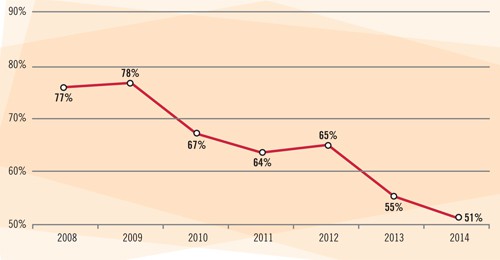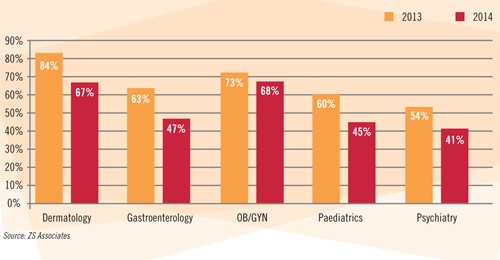
The number of doctors in the US willing to see sales representatives in person has been laid bare by a new report that illustrates the stark problems faced by pharma sales teams.
ZS Associates says that reps’ access to doctors has declined by a third over the last six years, and the consultancy lays the blame partly at healthcare professionals’ digital preferences.
The consultants point to an increasing number of younger doctors who would rather communicate with pharma companies and get their news via digital channels and mobile devices instead.
Accessible prescribers*

*Based on data for more than 240,000 prescribers
Source: ZS Associates
Pratap Khedkar, principal and leader of the pharmaceuticals practice at ZS Associates, said: “It’s not that these doctors object to receiving information from pharmaceutical companies. These doctors merely prefer using mobile and other alternative channels of communication to engage with reps.
“To take advantage of this change, companies must adopt an integrated ‘surround sound’ approach that uses several alternative methods to capture and keep a doctor’s attention. The trend is moving toward a mix of face-to-face communication with a handful of digital communication channels orchestrated by the rep.”
|
Three reasons why access won’t improve soon Pharmaceutical companies should be advised that the dynamics restricing access will continue. Khedkar cites three reasons that access will not improve:
|
The AccessMonitor report found the decrease in physician access was also being driven by the greater demands on doctors’ time and growth in payer/provider consolidation.
Previously rep-friendly specialists, such as those in dermatology, gastroenterology and paediatrics, were also found to be rapidly losing interest in rep visits, with dermatology seeing the biggest drop with a 16% dip in prescriber access from 2013 to 2014.
The report aggregates sales-call summaries from more than 200 US pharma sales teams and examines how often approximately 325,000 physicians and other prescribers meet with the sales reps that try to visit them.
Accessible prescribers for selected specialties

Source: ZS Associates
Physician access has been steadily declining over the last six years and 49% of those in the US now have ‘moderate-to-severe’ restrictions on rep visits in place – up from 23% in 2008.
Access continues to worsen despite swingeing cuts in the size of pharma’s field forces – last year Lilly set out plans to axe a third of its US reps and Novartis has already made major reductions, for example. As a result of these and other decisions the industry now employs more reps in China than it does in the US (which remains, for now at least, the industry’s single biggest market).
“Access still fell by a resounding one-third after companies cut the number of reps in the field,” Khedkar commented. “In fact, the number of reps will be likely to creep back up, serving to worsen access slightly.
“While it’s discouraging that doctors may not meet as often with pharma reps, most physicians still view these reps as valuable sources of information. Pharmacos just need to find new ways to reach these customers.”
Relationships reached by sales force size

Source: ZS Associates
Making proper use of that well-worn buzz word ‘customer-centric’ marketing will be key – along with careful channel choice – if pharma companies are to gain physician attention, but reps still have an important role to play, according to ZS Associates.
“It will become increasingly important for pharma companies to understand how physicians would like to be reached and coordinate their marketing messages across all communication channels,” Khedkar said. “The rep must play a critical role to help companies successfully orchestrate these channels and meet the specific needs of their customers.”
Looking to the industry’s future Khedkar concludes: “Access will not get much worse – but it will not get much better.”




